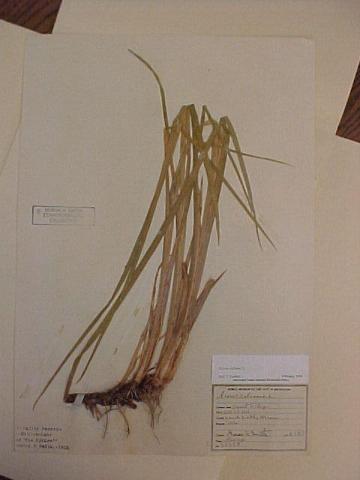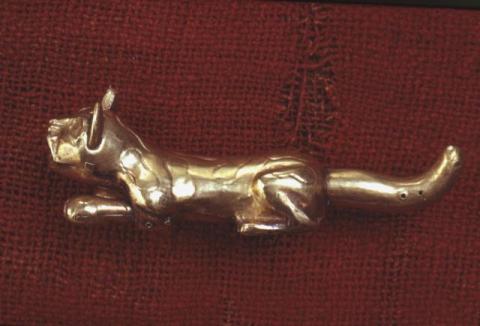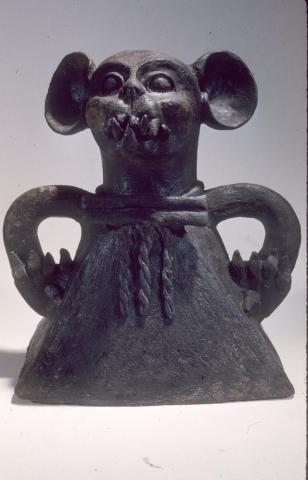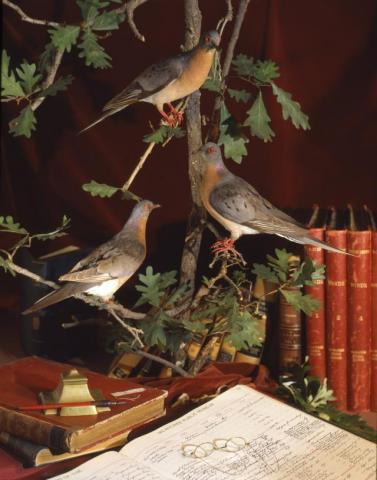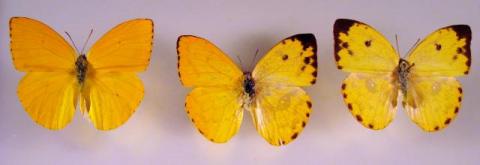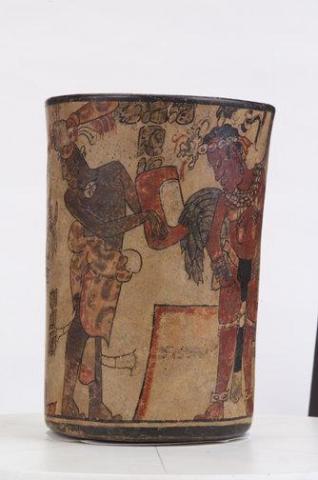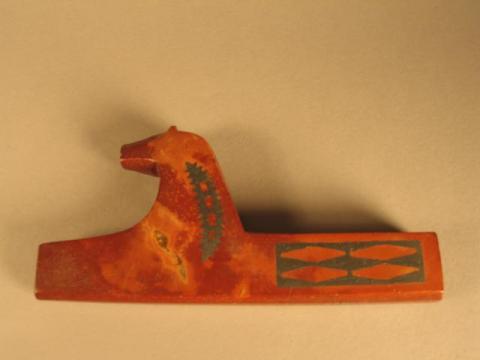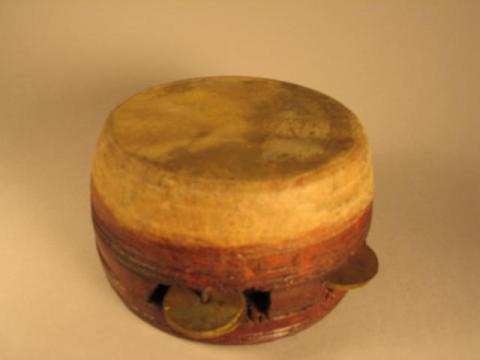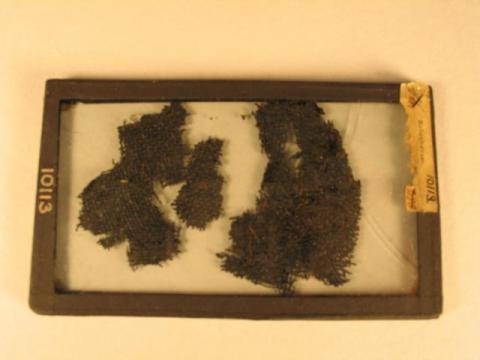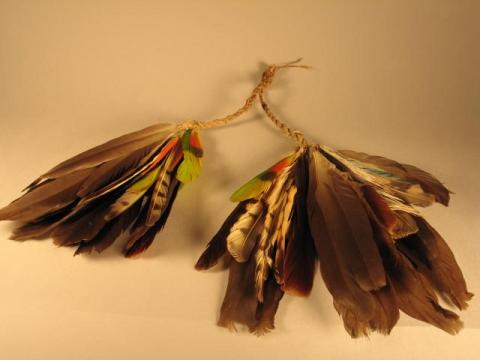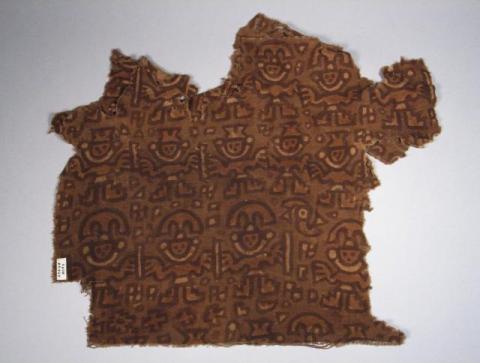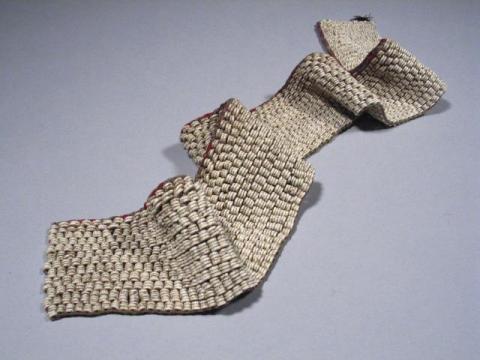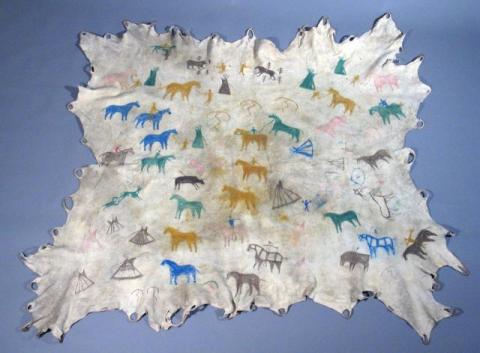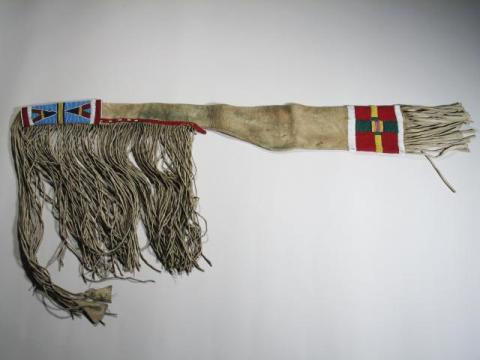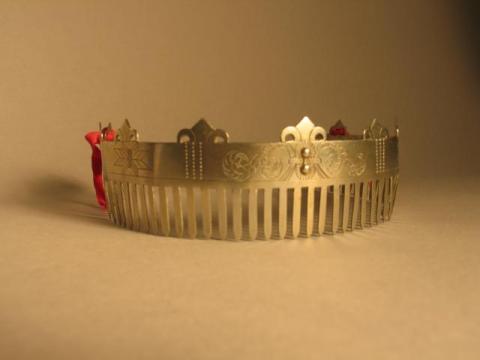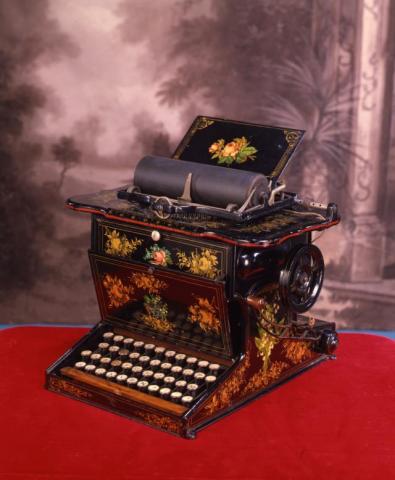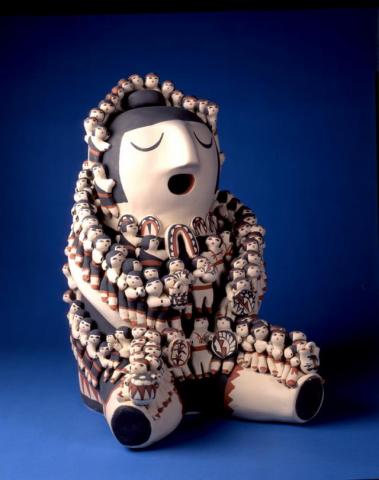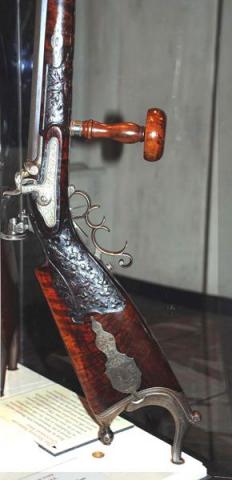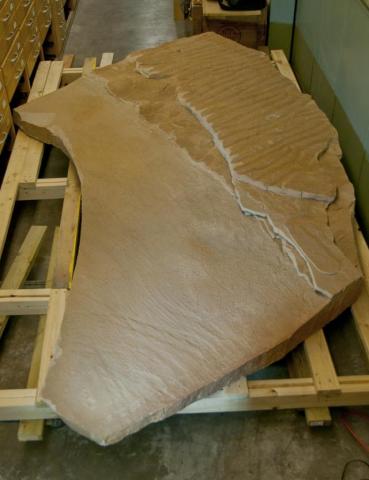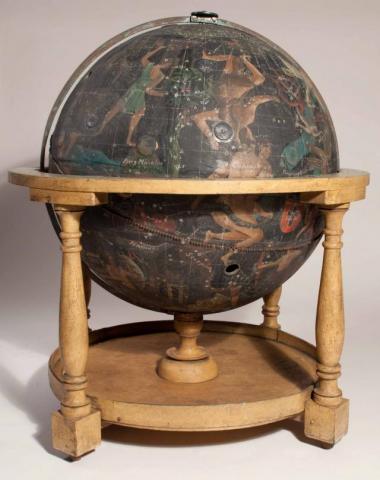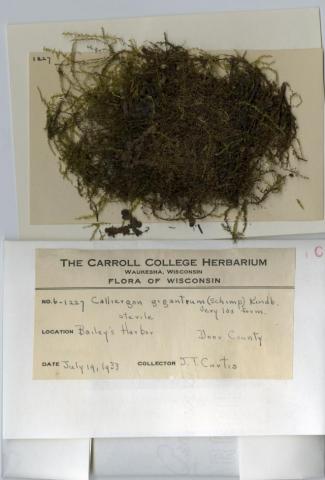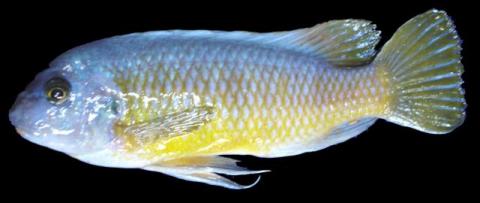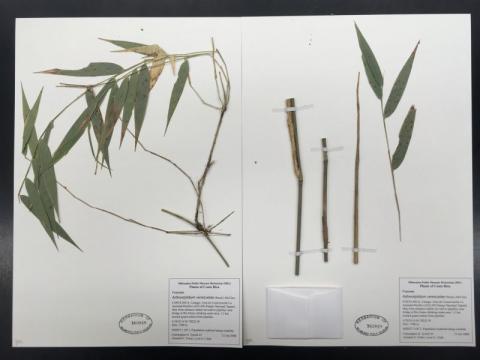MPM's curatorial and collections staff have selected more than 100 important, unique or interesting objects to highlight from the more than 4 million items in the Museum's care. These items reflect the depth and breadth of the collections.
Many of the items featured below are not on exhibit due to their fragile nature. One of the Museum's primary goals is to preserve objects for generations to come.
As a virtual exhibit, we can share with people around the world our most rare and intriguing items without harm to them.
This specimen is part of the Huron Smith Ethnobotanical collections. It was gathered during the 1920s when Smith was doing fieldwork among the Indian tribes of Wisconsin. He recorded the native name and use for the 1,600 plants he collected. This important collection was recently conserved using archival materials and rehoused in new cabinets, thanks to an IMLS grant. Smith's specimens, field notes and publications can now be viewed on the Museum's website here.
The Milwaukee Public Museum's Pre-Columbian Gold collection comes from Peru, Panama, Costa Rica, Colombia, and Mexico. Until the mid-1900s, such items were worth more as scrap than as artifacts and were melted down, losing a great amount of information. For this reason, museum collections are vital in providing information on Pre-Columbian gold working.
This artifact is a hollow jaguar fabricated from 12 pieces of sheet-gold. It dates to the Earliest Moche period (400-100 BC) and is from the Lambayeque Valley in northwest Peru. The jaguar is one of a set of seven identical pieces that were made by the same craftsman. The other jaguars in this set are in museums in Chicago, Richmond, Montreal, Lima, Munich, and Hamburg. This object and other examples of Pre-Columbian gold are on exhibit on the Third Floor mezzanine.
Milwaukee Public Museum director Dr. Stephan F. de Borhegyi spent many years excavating in and around Lake Amatitlán in Guatemala. This area was occupied over a great length of time by the Maya, from 500 BC to the Spanish Conquest (about AD 1500). Many items were brought up from the lake by divers, including several ceramic censers, containers used to burn copal incense, which played an important role in Maya rituals. The Milwaukee Public Museum is one of the primary repositories of artifacts from sites from this area. The Museum website has a page on the Lake Amatitlán collection and its history. You can also see the Lake Amatitlán exhibit on the Museum’s Pre-Columbian mezzanine.
Once the most common bird in North America, the passenger pigeon (Ectopistes migratorius) or wild pigeon lived in enormous migratory flocks that some estimate were between three to five billion upon European arrival.
The species went from being one of the most abundant birds in the world during the 19th century to extinction early in the 20th century. Some reduction in numbers occurred because of habitat loss when the Europeans started settling further inland. The primary factor emerged when pigeon meat was commercialized as a cheap food for slaves and the poor in the 19th century, resulting in hunting on a massive scale. Martha, thought to be the world's last passenger pigeon, died on September 1, 1914 in Cincinnati, Ohio.
The Milwaukee Public Museum has more than a dozen passenger pigeons in its Vertebrate Zoology department collection.
Over several decades, James R. "Jim" Neidhoefer, a local businessman with a passion for butterflies and moths, donated his collection of more than 100,000 specimens plus several hundred volumes of rare books and monographs on Lepidoptera.
Within this extensive collection are several hundred gynandromorphs, aberrant forms showing male characteristics on one side of the body and female on the other, and sexual mosaics, displaying mixed female and male characteristics. Gynandromorphism in particular is a rare condition that occurs in perhaps 1 in 50,000 moths and butterflies. The result is an error involving the sex chromosomes in the first cell division and the butterfly or moth is born sterile.
The photo shows Phoebis argante, a Sulfur butterfly (from Santa Catarina, Brazil). The bilaterial gynandromorph is shown between a normal male (left) and female (right) of the same species.
Thanks to Mr. Neidhoefer's donation, the Milwaukee Public Museum houses one of the largest and most extensive collections of these gynandromorphs in the world.
This collection of 21 items contains some of the most exquisite pieces in the Museum's Mesoamerican archaeological collection. Thomas Fifield, lawyer and Museum board member, and his wife Marilyn amassed the collection through art galleries, primarily in New York. Promised as a gift to the Museum many years ago, they were formally donated in 2006, just months before Tom passed on.
The "Artist's" Vase depicted here is Late Classic Maya (550-950 AD). The scene portrayed is that of a ruler being dressed inside his palace. One attendant holds a mirror as another presents the ruler with an elaborate mask or headdress. In contrast to other scenes of sacrifice and ritual, this is an unusually informal scene.
George West, a Milwaukee lawyer with a strong interest in archaeology, helped found the Wisconsin Archaeological Society in 1903. West also served on the Board of Trustees of the Milwaukee Public Museum for 32 years, for most of which he was president. Particularly interested in Native American pipes and smoking customs, West began collecting pipes around 1873 and continued to do so for several decades. The West pipe collection consists of 516 pipes; the majority are Native American. They represent all typical pipe styles found in the United States, three-fourths of them from Wisconsin. His is the largest single collection of Wisconsin pipes, and his two volume set Tobacco, Pipes, and Smoking Customs of the American Indians is still a primary reference.
Trinidad, one of the islands forming the Republic of Trinidad and Tobago in the southern Caribbean, has been ruled by several previous European powers, the last being Great Britain. On this small island, people from the various cultures of Asia, Europe, Africa, and native groups live and interact. This rare collection is from the East Indian peoples on the island and was collected by Milwaukee Public Museum Curator of Anthropology Dr. Arthur Niehoff in 1957. The East Indians were brought to the island by the British as indentured servants. The collection, one of only a few in the United States, is important since it shows the cultural exchange and influence that has occurred between the East Indians and the other groups inhabiting the island.
The Swiss Lake sites were first excavated in the mid-1840s and popularized by Swiss archaeologist Ferdinand Keller. Their interpretation as villages located over the lakes brought them much acclaim and made the collections from the sites' excavations much sought after by museums worldwide. Today, it is known that some, but not the majority, of these sites were built over water. They date from the Neolithic through the Bronze Age (4000 BC-700 BC). The sites are known for preservation of organic materials such as plant remains, wooden artifacts, bone, and textiles, like the one depicted here, that do not usually survive in the archaeological record. Most of the Swiss Lake collection at the Milwaukee Public Museum comes from the site of Robenhausen, Switzerland, located east of Zurich.
The Museum's Chamacoco Collection consists of 70 objects, such as this belt ornament made of tropical bird feathers, and represent items both for everyday use and for ceremonies. Collected in 1925 by the Museum of the American Indian in New York, they came to the Milwaukee Public Museum that same year. The Chamacoco live in the Gran Chaco region of northwest Paraguay. The Chamacoco today alternate between their traditional hunting and gathering and more recent light agriculture, craftsmanship, or labor. Their population has dwindled from several thousand to approximately 1,000 people today, and few museums in the United States have such collections.
The Milwaukee Public Museum has approximately 860 Peruvian textiles in its South American collection, a large portion donated in 1964 by collector Malcolm Whyte. Most of these items were obtained from the southwest coast of Peru and are associated with burials. The intricate textiles preserved by the dry, hot climate of the Peruvian desert coast, illustrate a variety of weaving and decorative styles, representing several different cultural periods. Items from the collection can be viewed on the Third Floor Pre-Columbian Mezzanine.
This ostrich shell belt was made by the San (Bushmen) of Botswana, a country in southern Africa. Ostrich shells play important roles in their culture, serving not only as beads for body ornamentation, but also as water storage containers, essential in the hot, dry environment in which the San live. To make beads, the egg shell is broken into small fragments, which are further shaped by hand into circular pieces. A small hole is drilled through the center of each bead. The whole process is by hand, so considerable time would have gone into the making of this belt. Jewelry made from ostrich shell is worn almost exclusively by women.
The painted Blackfeet elk skin robe in the Museum's collection came from Montana and is believed to have been painted by Mike Left Arm, showing his own exploits. The paintings depict primarily horse stealing scenes. Horses were important to the Blackfeet way of life, and it was a great achievement to acquire them through theft.
This Crow gun case was collected by Colonel J. J. Upham, a Milwaukee native, during his military service in the mid- to late 1800s on the Western frontier. Upham collected a variety of American Indian materials while stationed at military forts. His collection was donated to the Museum by his wife shortly after his death in 1898. The gun case is an excellent and rare example of Crow leather craftsmanship and bead working ability.
The Mexican Kickapoo reside on a reservation in the Santa Rosa Mountains of Coahuila. They originally inhabited land in northwest Ohio and southern Michigan, but were forced westward to northern Illinois and southern Wisconsin in the mid-1800s. They slowly spread westward into Kansas and south into Oklahoma, some reaching as far as northern Mexico. This collection comes from 1954 fieldwork conducted by Dr. Robert Ritzenthaler, Milwaukee Public Museum Curator of Anthropology, and from anthropologists Dolores and Felipe Latorre between 1960 and 1972. The Mexican Kickapoo are relatively isolated and reluctant to allow visits by outsiders. The collection, primarily consisting of clothing, basketry, and German silver jewelry and adornment is one of the largest collections of Mexican Kickapoo items in the United States.
The Carl P. Dietz Collection of business machines currently numbers approximately 1,200 machines of which 900 are typewriters. The collection reflects the diversity of typewriter manufacturers and the development of machines from the 1870s to the late 1980s. The Dietz Collection holds Museum-made models of the earliest typewriters designed by Christopher Latham Sholes, post-1873 Remington production models, and many seminal typewriters of the late 19th and early 20th centuries. The business machine collection is supplemented with a collection of typewriter trade literature (manuals & advertisements) and the James Densmore Papers related to the refinement of the Sholes typewriter.
Carl Praetorius Dietz (1875-1957) came to Milwaukee with his German immigrant parents in 1881. Dietz worked in various business endeavors before his election as justice of the peace in 1902. A well known socialist party member, he later served as an acting judge and City comptroller. He left office in 1912 to develop an insurance agency and was again elected to public office (10th Ward Alderman) in 1918. Dietz served on the board of the Milwaukee Public Library, was a Mason, a Knight of Pythias, and a member of the Old Setter's Club of Milwaukee. Carl P. Dietz worked with the Milwaukee Public Museum from the 1920s until his death to build a collection of typewriters memorializing the work of Sholes and to place the typewriter squarely in Milwaukee and American history.
This impressive ceramic storyteller was made by renowned Southwest artist Mary E. Toya of Jemez Pueblo in the early 1980s. At 19 inches tall and with 115 children attached, this is one of the largest and most intricate pieces of its kind. Storyteller figures symbolize the wisdom of elders and illustrate the importance of contact between generations. The value of stories is highly prized by American Indians and oral history is still a means of educating young people in the traditional knowledge and values of their cultures. The Museum acquired this piece in 1997 through the generosity of the late Donald S. Ackerman, his son Mark Ackerman, and his daughter Francine Huxley.
Made by Milwaukeean John Meunier (1834-1919) and displayed at the American Centennial Exposition in Philadelphia in 1876, this rifle is considered one of the most handsome and well-crafted schuetzen rifles extant. Meunier built this rifle as a tribute to his adopted Country and the discipline of German-style target shooting (schuetzen). This .41 caliber percussion rifle boasts silver-washed and engraved steel furniture with gold inlay and a beautifully carved stock demonstrating the meticulous work of the Meunier shop and John Meunier's personal dedication to the sport of schuetzen.
This 2,600-pound sandstone contains 500-million-year-old animal tracks . The fossil, donated by Eden Stone Company , is from Marathon County, Wisconsin and dates to the middle to late Cambrian period. The rock surface contains ripple marks and a fossil track named Diplichnites. The footprints were produced by a euthycarcinoid—an extinct, primitive arthropod.
The Celestial Globe (H57842/29193) was donated to the Milwaukee Public Museum in 1903 along with its companion terrestrial globe (H59492) and a manual of cosmic and terrestrial observations (H57843). The globe was developed by Johann Oelrich Kroehnke (1810-1897), an immigrant to New Holstein, Wisconsin in 1847. Kroehnke was a merchant, farmer, and community leader, and was intensely interested in intellectual pursuits and education, often at the expense of his personal fortune. The globes were developed, hand-painted, and built in Germany in the late 1830s by Kroehnke and brought to Wisconsin where they were used to educate his family and others in his community. Geographic data was updated between 1890-1892 to coincide with American populations and New World geography found in the 1890 United States Census.
John T. Curtis (1913–1961) was a renowned Wisconsin scientist best known for his contributions to the development of numerical methods in ecology and his seminal book, The Vegetation of Wisconsin: An Ordination of Plant Communities, published 1959. Curtis was born in Waukesha, WI and graduated from Carroll College (now University) in 1937. While an undergraduate at Carroll, Curtis made a substantial collection of bryophytes (mosses and liverworts) from around WI. These specimens have been on permanent loan to MPM for over 30 years and are critical research and comparative tools for understanding the natural history of Wisconsin bryophytes.
The cichlid fishes of the genus Labeotropheus were first described in 1927, when the type species L. fuelleborni was described as a new species by the German ichthyologist Ernst Ahl. A second species, L. trewavasae, was described in 1956 by the British zoologist Geoffrey Fryer. For the next 50 years, despite the tremendous scientific attention paid to understanding and delineating the fantastic diversity of cichlid fishes, no further species of Labeotropheus were described; in fact, many ichthyologists believed that no further species of Labeotropheuscould possibly exist.
In 2016, a description of two new species of Labeotropheus will be published by MPM Adjunct Curator and Research Fellow Dr. Michael J. Pauers. Dr. Pauers spent several years studying the body shapes of these fishes, and used this information, along with the unique breeding coloration of the males, to distinguish these two species from L. fuelleborni and L. trewavasae. Until the description is officially published, the names of these two new branches of the fish tree of life have to remain secret, so stay tuned for more news about these beautiful new fishes!
This rusty patched bumblebee (Bombus affinis) specimen was collected in 1915 in Milwaukee. Rusty patched bumblebees live in prairie ecosystems and collect pollen and nectar from a variety of plants. Once a common sight in Wisconsin, the northern Midwest, and the northeastern states, land use changes and habitat loss have caused a steep decline in rusty patched bee populations. The species was listed as Federally Endangered under the Endangered Species Act in January 2017. Along with over 3,000 other Apidae family bees, this bee has been photographed and had its label information transcribed. MPM's digitization efforts -- for bees and other natural history collections -- contribute to the growing network of specimen collections data available to scientists and researchers. Sharing data about our specimens helps scientists, landowners, and conservationists in their fight to bring the rusty patched bumblebee back from the brink of extinction.
It is estimated there are over 11,000 described tiger moth species worldwide. These moths are well known for their bright coloration, mimicry, and sophisticated defensive strategies. Many tiger moths feed on toxic plants and lichens as larvae (and in some cases, adults) in order to gain chemical protection against vertebrate predators. Some species use these toxic compounds for both defense and to attract and protect their mates. Other tiger moth species use sound production to ward off attackers – in some cases, jamming bat echolocation to avoid being eaten!
The MPM Invertebrate Zoology collection houses thousands of tiger moths from all over the world. Tiger moths also comprise a significant portion of the Milwaukee Public Museum’s famous Paulo Gagarin collection of butterflies and moths. Gagarin’s material originated from the biologically diverse Mata Atlantica of eastern Brazil. Over 90% of the habitat in this region has been lost due to deforestation and land use, thus, many of the MPM’s Gagarin moth specimens are considered rare and irreplaceable.
This is a specimen of the bamboo species Arthrostylidium venezuelae. A. venezuelae is one of over 400 species of bamboo that are native to Central and South America. Most American bamboos have small stems and use surrounding vegetation to help them stand upright. This specimen is from Costa Rica and it served as one of the sources of DNA used in a 2012 research paper on the evolution of woody bamboos of the New World tropics. American bamboo diversity and evolution is one of the many research areas that MPM curators have investigated over the years.


